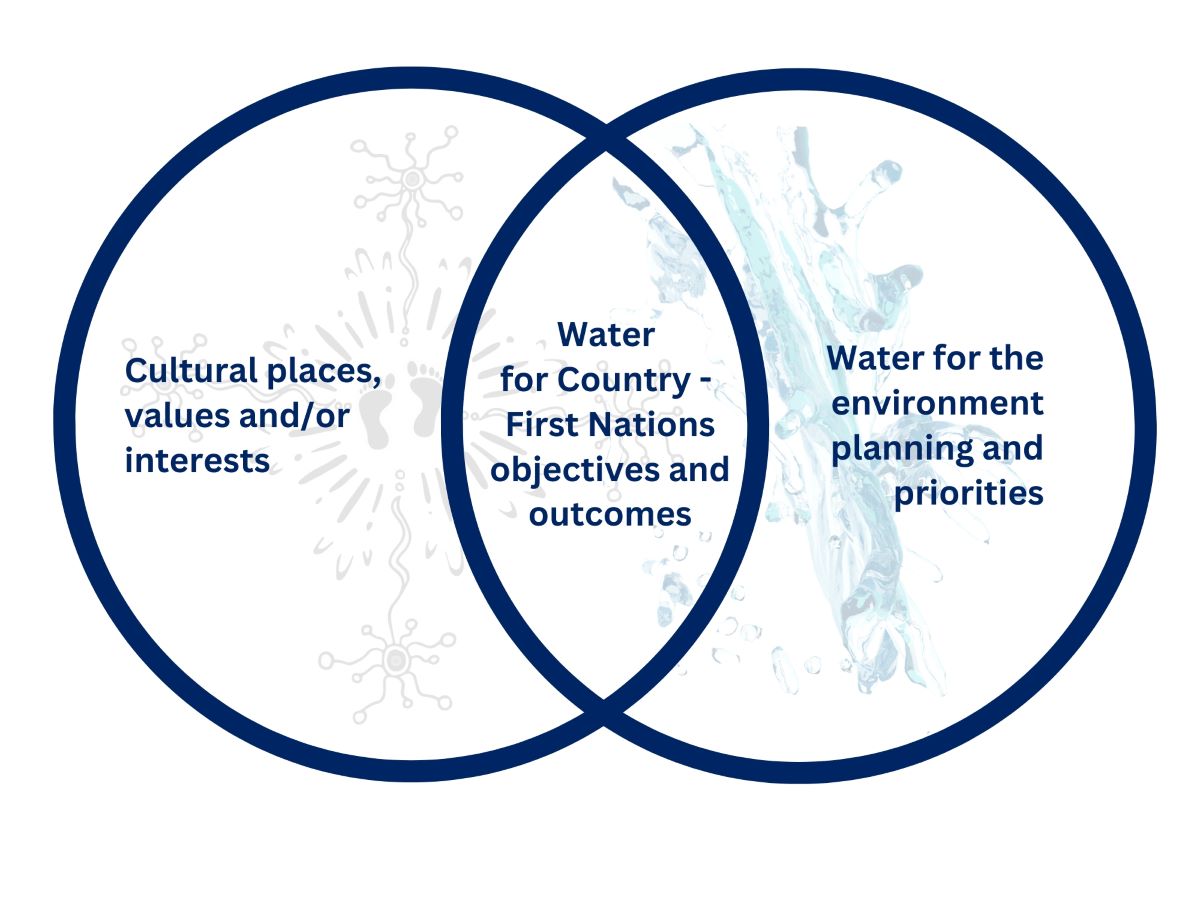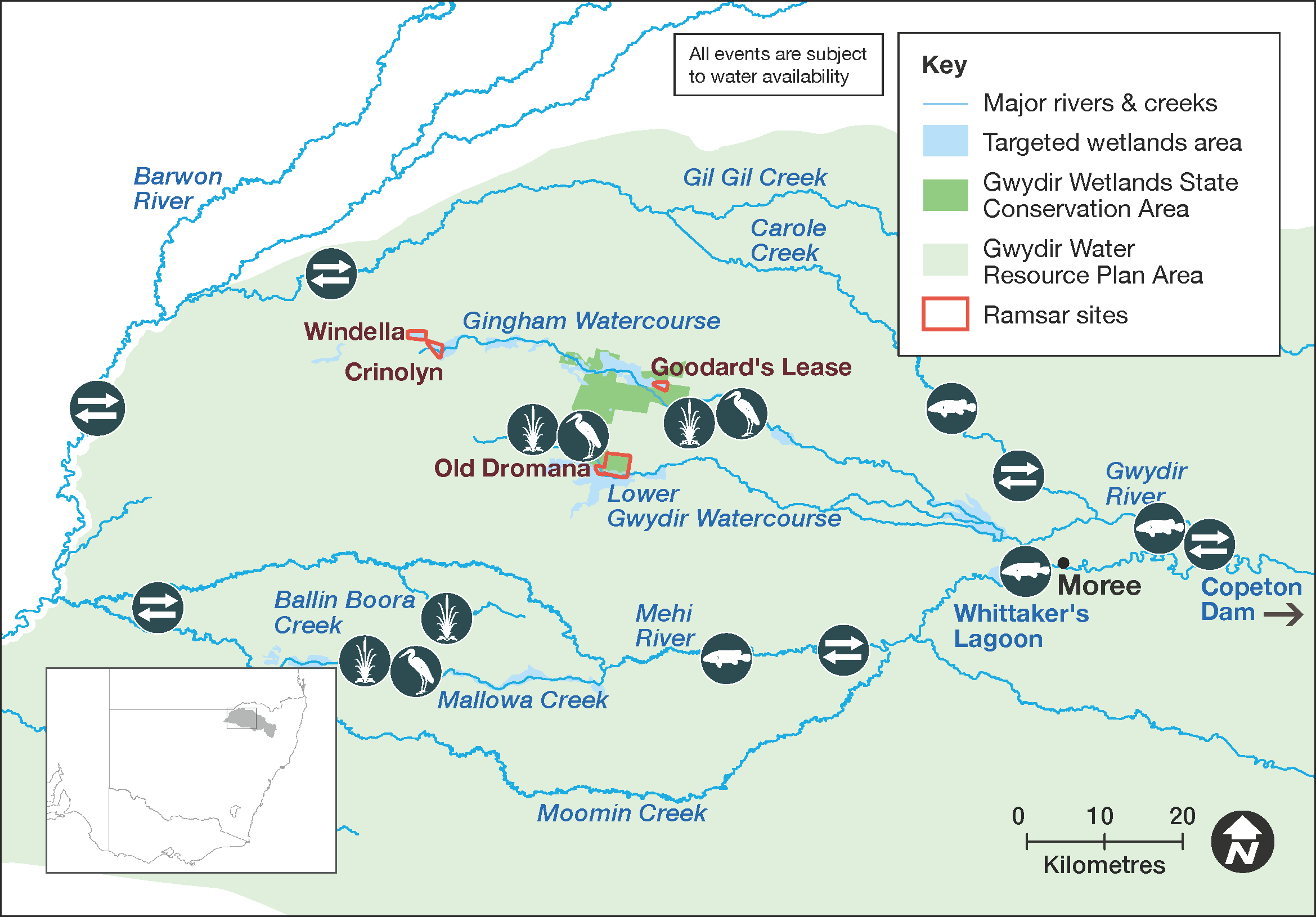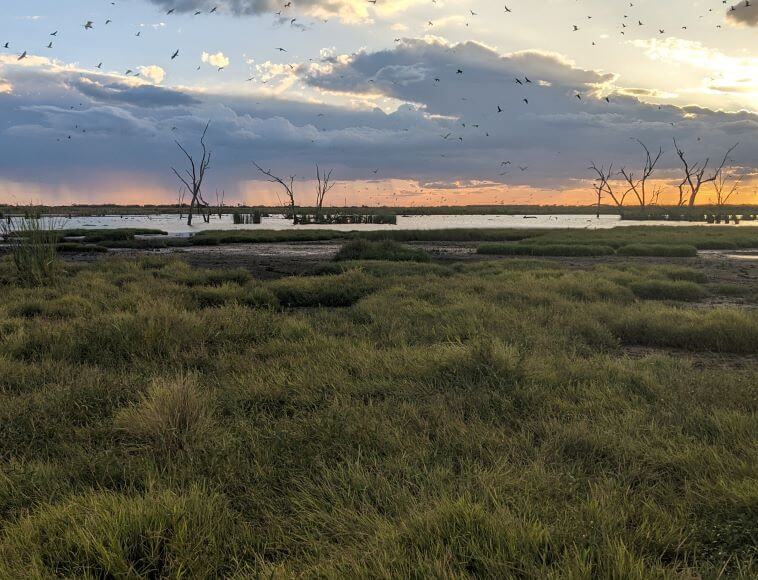Water that is allocated and managed specifically to improve the health of rivers, wetlands and floodplains is known as water for the environment.
NSW environmental water management teams work with local community advisory groups including landholders, Aboriginal stakeholders, partner agencies and other interested community members to develop detailed annual plans for the use of water for the environment in each catchment, including how its use is prioritised.
The catchment
The Gwydir catchment covers 25,596 square kilometres. The eastern upland creeks mainly flow into the Gwydir River upstream of Copeton Dam. Downstream, on the western floodplain, the Gwydir River splits into its main distributaries – the Mehi River (south), Carole Creek (north), Lower Gwydir and Gingham Channels (west/central). The Big Leather (Lower Gwydir) watercourse supports the state’s largest stand of marsh club rush. The Gingham Watercourse contains important colonial waterbird breeding habitats. The Gwydir wetlands are home to 4 wetland parcels listed under the Gwydir Ramsar landholder agreement.
The Gwydir catchment supports important Aboriginal cultural values for the Gomeroi/Kamilaroi people.
Water for rivers and wetlands
The Gwydir catchment experienced increasing wet conditions from 2021 to 2023. Major flooding occurred across the Gwydir River floodplain during March and April 2023.
Throughout the 2022–23 water year, water managers used water for the environment to support significant colonial waterbird breeding events in the Gwydir Wetlands after large-scale natural flooding. Other planned watering priorities in the system were achieved through natural and flooding flows.
Water in environmental accounts are currently full. In planning for 2023–24, water managers have applied:
- a set of principles and triggers to guide the watering of key water-dependent assets
- an adaptive approach to support fish and downstream ecological connectivity.
Measures are in place to provide water for any unforeseen water demands, such as for wetland fires and waterbird nesting.
With healthy account balances as of 1 July 2023, the Department of Climate Change, Energy, the Environment and Water (the department) can set aside water for use in future years to support the longer-term resilience of the catchment through drier times.
Aboriginal water management priorities

Environmental water managers have been working to support Aboriginal people’s priorities in water management.
Water for Country is environmental water use planned by the department and Aboriginal people to achieve shared benefits for the environment and cultural places, values and/ or interests.
We are establishing the Gwydir First Nations Environmental Water Group to provide a platform for Aboriginal people to have a voice and participate in environmental water management, programs and decision-making processes. We are working with members of the Gwydir Environmental Water Advisory Group (EWAG) to ensure Aboriginal people are part of the planning process to ensure decisions made uphold the responsibilities of Aboriginal people as custodians of Country and water.
Weather and water forecast
As at early June the El Niño–Southern Oscillation (ENSO1) outlook remains at El Niño alert. This means that while the El Niño–Southern Oscillation is currently neutral, there is a 50% chance that an El Niño may develop later in 2023. This is about twice the normal likelihood. El Niño typically brings hot, dry conditions to Australia, often leading to drought and bushfires.
Long-range forecasts show there's an increased chance of below average rainfall for most of Australia during autumn 2023. El Niño alert is not a guarantee that El Niño will occur but is an indication that some of the typical indicators of El Nino are currently occurring. All climate models surveyed by the Bureau suggest that El Niño thresholds are likely to be approached or exceeded during the southern hemisphere winter.
Water managers have prepared watering plans that consider a range of weather and water availability scenarios. This is known as resource availability scenario planning. Moderate to wet conditions are forecast for the Gwydir catchment in 2023–24.
1. ENSO: The interaction between the sea surface and atmosphere over the Pacific Ocean which results in dryer (El Nino) or wetter (La Nina) conditions.
Current forecast: Moderate to wet
| Conditions | Main aim | Other aims |
|---|---|---|
| Very dry | Protect | Avoid critical loss Maintain key refuges Avoid catastrophic events |
| Dry | Maintain | Maintain river functioning Maintain key functions of high priority wetlands |
| Moderate | Recover | Improve ecological health and resilience Improve opportunities for plants and animals to breed, move and thrive |
| Wet to very wet | Enhance | Restore key floodplain and wetland linkages Enhance opportunities for plants and animals to breed, move and thrive |
Key planned actions for 2023–24
Waterbirds
Heavy catchment rainfall, resulting in large river flows and floodplain flooding, may trigger colonial waterbird breeding events in the wetland systems. In response, water managers may provide 15–25 gigalitres (GL) of held water for the environment to support these events.
Native fish
Water managers may use up to 25 GL to support native fish communities this season. In the absence of large natural flows, a release downstream of Copeton Dam will be made to stimulate early season river productivity with supporting environmental flows later in the season.
Vegetation
Water managers may use up to 20 GL across the catchment. Rainfall may trigger delivery of held environmental water into the Mehi River, Carole Creek and/or the Gwydir wetlands system. Water managers may also provide flows into the Mallowa Creek this season to continue ecological improvements and as part of their seasonal planning for this watercourse.
Connectivity
Water managers may provide water for the environment into the Carole Creek, Mehi and Gwydir rivers this season for connectivity support to native fish communities during possible extended dry periods. In addition to inter-catchment connectivity, water managers may consider addressing connection to the Barwon Barwaan River if warranted during the year.
Map of proposed annual priority targets in the water resource plan area 2023–24

Map of proposed annual priority targets in the Gwydir Water Resource Plan area 2023–24
The Department of Climate Change, Energy, the Environment and Water (the department) is supporting the health and resilience of rivers and wetlands by delivering water for the environment where and when it is needed. We use the best available science, management expertise and experience to manage water across the landscape. This statement of annual priorities identifies the waterways and wetlands that are likely to receive water.
Our decision-making process considers:
- expected availability of water in the coming year
- conditions of the previous year
- current health of the plants and animals in these ecosystems.
About water for the environment
Water for the environment delivers benefits for communities, rivers, wetlands and wildlife across New South Wales.
Healthy, connected rivers and floodplains are a focus for tourism, fishing, recreation and relaxation. Rivers carry water to our homes, schools, farms and businesses, and along the way, support countless species including native fish, waterbirds, frogs, plants and more.
Rivers and wetlands have great cultural and spiritual significance for Aboriginal people.
Water for the environment is a critical tool to maintain and enhance the rivers, wetlands and wildlife we all love.
Working with communities
Local communities are at the heart of everything we do.
We involve the broader community by holding site tours and forums, and online and in-person events.
NSW water management teams consult regularly with community-based environmental water advisory groups.
Environmental water advisory groups members include local landholders, recreational fishers, Aboriginal people and local government representatives. Their advice helps to inform the decisions made by our local environmental water management teams.
Planned environmental water
| Source | Maximum volume available (gigalitres) | Volume expected 1 July under current conditions (gigalitres) |
|---|---|---|
| Environmental water allowance | 90 GL | 90 GL |
Water licenced to New South Wales
| Source | Maximum volume available (gigalitres) | Volume expected 1 July under current conditions (gigalitres) |
|---|---|---|
| General security | 25.5 GL | 25.5 GL |
| Supplementary | 3 GL | Event-dependent |
| High security | 1.2 GL | 1.2 GL |
Water licenced to the Commonwealth
| Source | Maximum volume available (gigalitres) | Volume expected 1 July under current conditions (gigalitres) |
|---|---|---|
| General security | 134.2 GL | 134.2 GL |
| High security | 4.5 GL | 4.5 GL |
| Supplementary | 20.4 GL | Event-dependent |
Notes: This is an indicative summary of expected volumes to be available. For further detail and information on available volumes you can contact the region via the Department of Climate Change, Energy, the Environment and Water on 1300 361 967.
1 gigalitre = 1000 megalitres; 2.5 megalitre = 1 Olympic swimming pool.
Outcomes of water for the environment
Water for the environment has been delivering outcomes for rivers, wetlands and wildlife for 30 years.
We deliver flows that:
- trigger native fish to breed and move
- support waterbirds to nest and feed
- connect rivers and floodplains
- water forests and floodplains
- allow plants to grow, flower and set seed
- create refuge during droughts
- enhance outcomes during wetter times
- release vital nutrients from the floodplain floor that underpin the aquatic food web.
It’s habitat restoration on a landscape scale.

The Gwydir Wetlands are an important breeding area for waterbirds
More information on planned and past watering events
- Annual environmental water priorities in the Gwydir catchment 2022–23
- Gwydir Catchment – Water for the environment: Annual priorities 2021–22
- Gwydir catchment: Annual environmental watering priorities 2020–21
- Gwydir: Annual environmental watering priorities 2019–20
- Gwydir catchment: Annual Environmental Watering Priorities 2018–19
- Gwydir catchment: Annual environmental watering priorities 2017–18
- Gwydir Water Resource Plan Area: Statement of annual environmental watering priorities 2016–17
- Gwydir Water Resource Plan Area: Statement of annual environmental watering priorities 2015–16
- Water for environment outcomes 2022–23
- Water for environment outcomes 2021–22
- Use of water for the environment in NSW: Outcomes 2020–21
- Use of water for the environment in NSW: Outcomes 2020–21
- Use of water for the environment in NSW: Outcomes 2019–20
- Use of water for the environment in NSW: Outcomes 2018–19
- Use of water for the environment in NSW: Outcomes 2017–18